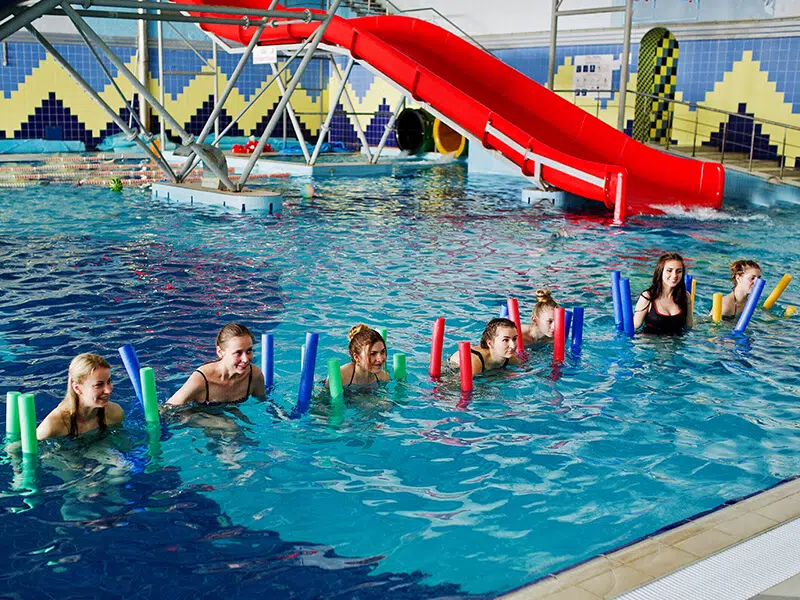You can do aquagym from the beginning of your pregnancy, and that until its end! Water makes this gentle activity for your joints and can even help you prepare for childbirth.
As long as the exercises don't hurt or trigger labor, there's no problem!
You want to know what are the benefits prenatal aquagym? What are the precautions to take? In this case, this article is for you! Let's go, we'll explain everything to you.
Why do aquagym when pregnant?
Doing aquagym while pregnant is a good way to practice a physical activity sweet and moderate with many benefits. Prenatal aquagym has benefits for your body, because:
- Water supports your weight and reduced THE shocks to the joints
- Water creates a natural resistance which strengthens your muscles
- Water gives a feeling of weightlessness which relieves your tensions
Playing sports in water has many benefits benefits. This is why practicing aquagym while pregnant allows you to:
- Relieve your pain (heavy legs, back pain, etc.)
- Improve your blood circulation (especially in the lower limbs)
- Prepare your childbirth (working on your flexibility and your perineum)
- To struggle against against the appearance of the cellulite
- Improve your breathing
- Prevent the edema
- Potentially reduce the risk of gestational diabetes
- Soothe the tensions and reduce the stress while relaxing
- Win in trust In you
- Keep a certain physical fitness
- Promote the postnatal recovery
- Share a pleasant moment with other expectant mothers
Compared to other physical activities (walking, pilates, yoga, etc.) prenatal aquagym is an activity that is often more suitable for expectant mothers.
There walk maybe embarrassing if you have any pain at the pelvis or heavy legs. While aquagym will allow you to move without feeling the weight of the baby in your belly.
THE yoga and the pilates can be complicated if you have any concerns of balance and of flexibility. Whereas with aquagym, the water holds you and allows you to make movements without the risk of falling.
And because water aerobics is a gentle activity, you can take classes at virtually any point during your pregnancy!
When to start prenatal aquagym?
You can to start prenatal aquagym from the beginning of your pregnancy. But for that you need to have the agreement of your midwife or your doctor.
Usually, expectant mothers take part in aquagym classes during the 2nd quarter, towards the 3rd month. This is when the body begins to change and discomfort and pain set in.
We therefore recommend that you do aquagym around the 3rd month. Like this, you will be able to take care of your body with a little water sport.
The great thing about prenatal water aerobics is that you can do it until the end of your pregnancy. The exercises are not painful and do not impact the onset of your labor.
Level frequency, talk about it with your doctor or your midwifeThey will give you recommendations based on your fitness level and the progress of your pregnancy.
Ideally, 2 weekly sessions of approximately 1 hour allow you to enjoy the benefits of aquagym while pregnant. But be listening to your body and don't absolutely try to do 2 classes per week.
WHO recommends that pregnant women practice 150 minutes of moderate physical activity per week. And that's good, because prenatal aquagym ticks all the boxes!
Indeed, aquagym is a moderate activity. She asks for your heart and your muscles without getting out of breath or tiring yourself out. So if you can manage to do 2 1-hour sessions per week, it can only do you good.
Anyway, before you start, take a quick trip to your doctor or your midwife. This way you make sure that aquagym East adapted for you. In addition, they will give you a medical certificate.
As soon as you have your certificate of no contraindication, you will be able to participate in your prenatal aquagym sessions!
How does a prenatal aquagym session take place?
Prenatal aquagym sessions last approximately 50 minutes and are done in small groups. You are in a pool around 30°C and you are accompanied by a midwife or a.e specialized coach.
A aquagym session prenatal takes place in several phases :
- Warming up, to wake up the body's muscles and prepare your heart for the effort, for about 10 minutes.
- Of the cardiovascular exercises, to get your heart rate up a bit and burn calories, for about 15 minutes.
- Of the strengthening exercises, to tone thighs, glutes, back, arms and shoulders, for around 15 minutes.
- Of the stretching and relaxation exercises, to loosen your joints, avoid aches and relax, for about 10 minutes.
At the end of your session, you will feel light and relaxed. Nothing better to make you feel good during your pregnancy!
There are also other forms of prenatal aquagym. So, you can have fun testing:
Our advice for practicing aquagym during your pregnancy
Among the tips for practicing aquagym properly, the most important are:
- Choosing a suitable pool
- Wear a comfortable jersey
- Hydrate before, during and after class
- Adapt the intensity and duration of the sessions
- Avoid sudden movements
- Listen to your body
1. Choose a suitable pool
The ideal is to choose a pool where you have foot and with a heated water around the 30°C. And if possible, opt for a pool treated with salt or another process, rather than chlorine. Chlorine is not necessarily your best friend…
2. Wear a comfortable swimsuit
Wear a swimsuit Comfortable in normal times is already important, but when you are pregnant it is even more important. You must feel comfortable in the water.
Swimsuits that are too tight or too low cut may restrict your movement or irritate your skin. Instead, try choosing a one piece swimsuit or one tankini with a good support at the level of the belly and chest.
And it's even better if your swimsuit dries quickly and is resistant to chlorine or other treatment products.
Also think about ask if you have need other accessories. Sometimes you need to wear a swimming cap and swimming shoes or socks.
3. Hydrate before, during and after your class
Just because you're exercising in the water doesn't mean you shouldn't drink water! You'll lose just as much water as you would if you were doing a "classic" sport.
Remember to drink plenty of fluids before, during and after your aquagym class. It will help you avoid there dehydration and the cramps. You are recommended to drink at least 1.5 liters per day.
During your session, take a bottle or a gourd that you keep close to you. Try to drink small sips enough often rather than finishing your water bottle in one go…
4. Adapt the intensity and duration of your sessions
Depending on the stage of your pregnancy, you must adapt the intensity and duration of your aquagym sessions. The reason is simple: it is to avoid from you hurt or you to tire.
We recommend that you start slowly, then gradually increase the pace and duration of practice. Above all, respect your limits. Don't force it. If you have pain, it's better to take a break or stop.
Also try to do pay attention to your heart rate. If you feel your heart beating very fast, reduce the intensity. The goal is not to put your heart in the red, but to make it work gently.
5. Avoid sudden movements
Sudden or risky movements may cause contractions or some falls. That's why you should try to avoid them.
For example, jumping, excessive extensions of the back or stomach are movements to avoid. Prioritize rather the fluid movements and controlled.
6. Listen to your body
It is important to listen to the feelings of your body to know when to say stop. We advise you to do a break or stop if you feel:
- A pain
- A embarrassed
- A shortness of breath
- Of the dizziness
- A start of faintness
And if you ever have any contractions abnormal, you bleed or the poached waters have opened, consult your doctor quickly doctor.
How to find a prenatal aquagym class?
To find a prenatal aquagym class, you can contact:
- Your maternity
- Your pool municipal
- Your sports club
Ask your maternity ward
Your maternity ward can help you find course aquagym which are part of the preparation for childbirth. This way, you can benefit from a reimbursement from Social Security. Provided that the sessions are supervised by a midwife.
Please note that these courses are often prized. Moreover, the schedules are not not always flexible. But with a bit of luck, you will find a course!
Ask your municipal swimming pool
Do not hesitate to ask your pool municipal if it offers aquagym classes for pregnant women. It could be a practical solution close to you and at a price affordable.
However, in some municipal pools, the water quality is not always the best. To be sure, you can make a phone call and ask for details.
In the swimming pool, there is often many expectant mothers who participate in prenatal aquagym classes. It's not the most pleasant thing, but at least you meet other expectant mothers. It's a chance to chat!
Ask your sports club
It could be a good alternative to inquire at your sports club. They often offer aquagym sessions adapted to different levels. It is therefore possible that classes for pregnant women exist.
But you must be sure that the pool is reserved for these lessons and that the coach is good qualified. For frame of the pregnant women.
Are there any contraindications to practicing aquagym during pregnancy?
There are some contraindications to practicing prenatal aquagym. Especially if you have medical history or some complications as :
- Of diabetes, which can lead to hypoglycemia during exercise
- Of high blood pressure, which can cause placental abruption and preeclampsia
- Of the heart disease Or respiratory, which can limit the blood's oxygenation capacity
- Of the urinary tract infections Or vaginal, which can spread to the uterus or kidneys
- Of the perineal weaknesses which can lead to urinary leakage
We repeat ourselves, but to ensure that you are fit to do aquagym, consult your doctor or your midwifeThey will tell you how to adapt your practice.
Beyond complications and medical history, you need to avoid prenatal aquagym if you have :
- Of the bleeding
- A wound unhealed or healing
- A allergy to chlorine or treatment products
- Of the contractions regular
And of course, if your water breaks and you know that premature labor may occur, you should also avoid water aerobics.
Either way, once your little baby has arrived and is part of the family, you can start water aerobics again!
How to resume aquagym after giving birth?
For resume aquagym after your childbirth, you must take precautions :
- Wait until the bleeding stops and the perineum has healed
- Ask your gynecologist or midwife for permission
- Resume gradually and at your own pace
- Adapt your practice
Wait until the bleeding stops and the perineum has healed
It is essential to wait until the bleeding has stopped and your perineum has healed before avoid THE infections and the complications.
Before resuming aquagym, count about 4 to 6 weeks after childbirth by low way. And for a cesarean section, count 8 weeks before resuming your sessions.
Ask your gynecologist or midwife for permission
To be sure that there are no risks, you must ask for agreement of your gynecologist or your midwife before resuming aquagym. They are the ones who will tell you when and how to start again properly.
In particular, you will make a postnatal assessment with your gynecologist and your midwife. The goal is to know how you feel and how your body experienced childbirth. This way, you can adapt the recovery.
Resume gradually and at your own pace
It is important to resume aquagym at your own pace and taking the time it takes. This will allow you to don't tire yourself out and avoid you hurt.
Start slowly and increase little by little the intensity and pace of your aquagym sessions. You must listen to your body and your feelings so as not to force yourself and risk hurting yourself.
Adapt your practice
After giving birth, you will not be able to resume aquagym as you did before. You will have to adapt your practice and:
- Choose some exercises depending on your level and yours goals
- Avoid exercises too intense or which put too much strain on your perineum
Prioritize THE exercises who go gently strengthen : your perineum, deep abdominal muscles and your back. Avoid anything that might hollow out your stomach or pull on your scars.
Also try to to favor THE smooth movements, fluids And controlled. Jumping, squatting or rapid knee raises are not the most appropriate postpartum exercises.
Frequently asked questions about aquagym and pregnancy
Is prenatal aquagym dangerous for babies?
No Aquagym is not dangerous for your baby. As long as you practice with moderation and that there is a follow up with your doctor and your midwife, there is no problem.
On the contrary, prenatal aquagym can to favor THE baby development by improving blood circulation and oxygenation of the placenta.
Can aquagym during pregnancy induce labor?
No, aquagym cannot induce labor if your cervix East farm and that the poached waters is intact. On the other hand, as you go strengthen your perineum, it can make the work easier.
Is prenatal aquagym reimbursed by Social Security?
Yes, prenatal aquagym can be reimbursed by Social Security and certain mutual insurance companies. On the other hand, it must be done part of childbirth preparation and that she be supervised by a midwife.
To find out about reimbursement terms, we advise you to contact your health insurance fund.
Does prenatal aquagym help you lose weight after giving birth?
Yes, prenatal water aerobics can help you lose weight after giving birth if your food East adapted.
Aquagym allows you to to strenghten your muscles gently and burn calories. You just need to eat well, and in reasonable quantity, to lose weight.
On the other hand, don't expect miraculous results. Aquagym is a gentle activity. The ideal is to associate it with a other sporting practice to spend more.
Is aquagym easy to do during pregnancy?
Yes, aquagym is easy to do when you are pregnant. You don't have to not necessarily need to know how to swim (it depends on the pools) and the exercises are easy. In addition, a. coach specialized or a midwife is here for you to guide.
Is aquagym compatible with other activities?
Yes, aquagym is compatible with other activities. We even recommend that you vary activities physical exercises during your pregnancy. You can combine water aerobics with walking, yoga or even pilates.
It all depends on your preferences and of how your body reacts to your pregnancy. But some sports are still more suitable than others.
Is aquagym accessible to all expectant mothers?
Yes, all expectant mothers can do prenatal aquagym. As we told you above, you just need to have the green light of your doctor or your midwife. Then you just have to find a suitable course.
Conclusion
Prenatal aquagym is a moderate physical activity perfect for keep fit during your pregnancy. It can even help you prepare for your delivery !
This practice is just as beneficial for your body that your moral. This is what Julie, young mother and Aqua by member, shared with us.
During her pregnancy, aquagym helped Julie to reduce his pain at the back, at better breathe and to relax.
So, for a pregnancy all in relaxation, for you and for baby, try prenatal aquagym !
Aquabike for pregnant women at Aqua by
You want to practice Prenatal aquagym differently ? In this case, come to Aqua by discover our sessions aquabike for expectant mothers.
Aqua by it's a studio aquabiking which offers you the chance to discover a real sports experience. And all this gently thanks to the benefits of water.
Discover aquabiking in a different way with 45 minute sessions thoughts for let goOur coaches accompany you during each session and help you adapt the movements.
THE course are accessible to everyone, whatever your level. And of course, you can participate in the sessions thoughts for the future mothers.
So if you want to do some sport during your pregnancy all in candy, come and test prenatal aquabike at Aqua by.
Our 4 studios located at Paris (Réaumur, Bastille, Charonne) and Boulogne are just waiting for you and your baby. 💦









